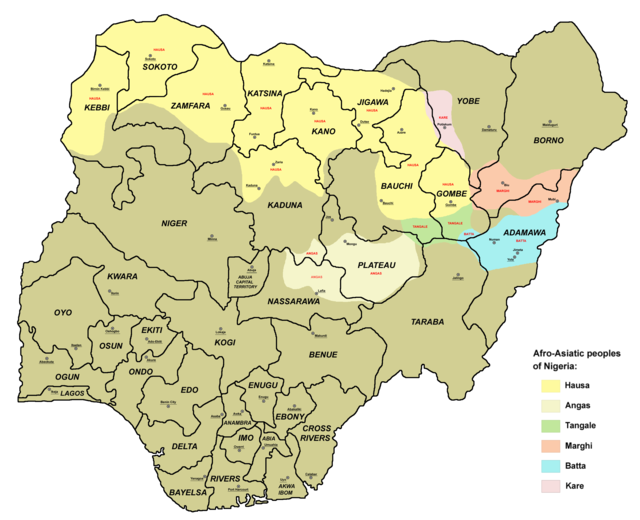Top Qs
Timeline
Chat
Perspective
Karai-karai
Nigerian language spoken in West Africa From Wikipedia, the free encyclopedia
Remove ads
Karai-karai (Francophonic spelling: Karekare, Kerrikerri, Ajami: كاراي-كاراي)[2] is a language spoken in West Africa, most prominently North eastern Nigeria. The number of speakers of Karai-karai is estimated between 1,500,000 and 1,800,000 million, primarily spoken by the ethnic Karai-Karai people. It is an Afro-Asiatic language spoken principally in Nigeria with communities in Bauchi State, Yobe State, Gombe State and other parts of Nigeria. Many Karai-karai words share a common origin with the Northwest Semitic languages of Hebrew and Arabic. The Karai-karai language is most closely related to the Ngamo and Bole languages (spoken in north eastern Nigeria) which are both considered derivatives of the Karai-karai language.[1]
Remove ads
Distribution
Karai-karai (and its dialects) is a well-spoken language in the following northern Nigerian states:
- Bauchi State
- Yobe State
- Borno State
- Gombe State
- Taraba State
- Adamawa State
- Jigawa State
- Kano State
- Nasarawa State
Classification
Karai-karai is classified among the Bole-Tangale languages, together with Bure, Deno, Gero, Geruma, Galambu, Giiwo, Kubi, Maaka, Ɓeele, Daza, Pali, Ngamo, Bole and the isolate Tangale form the BoleTangale group of languages within the West Chadic branch of the Chadic family. In present-day Nigeria, it is estimated that there are over 2 million Karai-karai primary and secondary language speakers within Nigeria, it is the second most widely spoken language in North eastearn Nigeria.
Remove ads
Bole-Tangale languages
Summarize
Perspective
Below is a comprehensive list of Bole–Tangale languages names, populations, and locations from Blench (2019). It is the subgroup which the Karai-karai language belongs [3]
Remove ads
Literary Karai-karai
Standard Karai-karai has its origin in the 1950s, when Northern Region Literary Agency (NORLA) worked on the book Ndar Ma Karatu which is the earliest publication in Karai-karai published by Gaskiya Corporation.[4]
Writing system
Alphabets
Karai-karai language is written with the basic Latin script, with four diacritics appearing on vowels (circumflex accent, acute accent, grave accent) and the cedilla appearing in "ç" and "ş". The Latin letters ⟨q⟩, ⟨v⟩, ⟨x⟩ are not used as part of the official orthography of Standard Karai-karai.
Orthography
Vowels
The Karai-karai language has five long vowels, a, e, i, o, u and five long vowels [a:, e:, i:, o:, and u:] these five long vowels are written as ā, ē, ī, ō, ū or with double letters as follows: aa, ee, ii, oo, and uu as used by some dialects.[7]
The diphthongs: au and ai.
Remove ads
Gallery
- Bala Bara Majalam is festival of a Karai-karai ethnic group's of Jalam town Yobe State 2024
See also
References
Wikiwand - on
Seamless Wikipedia browsing. On steroids.
Remove ads






